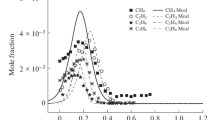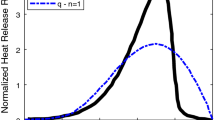Abstract
A kinetic modeling of pollutant formation in hydrocarbon flames is presented through analysis of hierarchical structures. Based on the newly released GRI-Mech 3.0, it was mainly taken from Dean and Bozzelli (DB) and Wang mechanism respectively for the nitrogen chemistry, the formation and growth of polycyclic aromatic hydrocarbons (PAH). The modeling was improved by considering C4 and Howard’s PAH chemistry. The mechanism consists of 121 species in 731 reactions. Two premixed flame structures are predicted, and the computed results are compared with the experimental ones. It is shown that the mechanism predicts reasonably well the concentration profiles of major, key intermediate and minor species.
Similar content being viewed by others
References
Richter, H., Howard, J. B., Formation of polycyclic aromatic hydrocarbons and their growth to soot —a review of chemical reaction pathways, Progress in Energy and Combustion Science, 2000, 26: 565–608.
Violi, A., D’Anna, A., D’Alessio, A. et al., Modeling aerosol formation in opposed-flow diffusion flames, Chemosphere, 2003, 51: 1047–1054.
Levin, B. C., Braun, E., Navarro, M. et al., Further development of the n-gas mathematical model: an approach for predicting the toxic potency of complex combustion mixtures, American Chemical Society, Fire and Polymers II: Materials and Tests for Hazard Prevention, National Meeting, 208th, 1995.
DeRosa, M. I., 20-L furnace test method to determine the combustion gas toxicity of conveyor belts, National Institute of Standards and Technology, Annual Conference on Fire Research, Gaithersburg, MD, 1996.
Dupont, V., Williams, A., NOx mechanisms in rich methane-air flames, Combustion and Flame, 1998, 114: 103–118.
Richter, H., Grieco, W. J., Howard, J. B., Formation mechanism of polycyclic aromatic hydrocarbons and fullerenes in premixed benzene flames, Combustion and Flame, 1999, 119: 1–22.
Richter, H., Benish, T. G., Mazyar, O. A.et al., Formation of polycyclic aromatic hydrocarbons and their radicals in a nearly sooting premixed benzene flame, Proceeding of the Combustion Institute, 2000, 28: 2609–2618.
Olten, N., Senkan, S., Formation of polycyclic aromatic hydrocarbons in an atmospheric pressure ethylene diffusion flame, Combustion and Flame, 1999, 118: 500–507.
Tregrossi, A., Ciajolo, A., Barbella, R., The combustion of benzene in rich premixed flames at atmospheric pressure, Combustion and Flame, 1999, 117: 553–561.
Gasnot, L., Desgroux, P., Pauwels, J. F. et al., Detailed analysis of low-pressure premixed flames of CH4 + O2 + N2: a study of promptNO, Combustion and Flame, 1999, 117: 291–306.
Senkan, S., Castaldi, M., Formation of polycyclic aromatic hydrocarbons (PAH) in methane combustion: comparative new results from premixed flames, Combustion and Flame, 1996, 107: 141–150.
Hai, W., Frenklach, M., A detailed kinetic modeling study of aromatics formation in laminar premixed acetylene and ethylene flames, Combustion and Flame, 1997, 110: 173–221.
http://www.me.berkeley.edu/gri_mech/.
Hughes, K. J., Tomlin, A. S., Hampartsoumian, E. et al., An investigation of important gas-phase reactions of nitrogenous species from the simulation of experimental measurements in combustion systems, Combustion and Flame, 2001, 124: 573–589.
http://www.chem.leeds.ac.uk/Combustion/.
Nafe, J., Mass, U., Hierarchical generation of ILDMs of higher hydrocarbons, Combustion and Flame, 2003, 135: 17–26.
Mass, U., Thévenin, D., Correlation analysis of direct numerical simulation data of turbulent non-premixed flames, Twenty-Seventh Symposium (International) on Combustion/The Combustion Institute, 1998, 1183–1189.
Chuli, Y., Study on ILDM and numerical predictions of flame structure with detailed chemistry, BS Thesis, University of Science and Technology of China, 2004. 6.
Miller, J. A., Bowman, C. T., Mechanism and modeling of nitrogen chemistry in combustion, Progress in Energy and Combustion Science, 1989, 15: 287–338.
Author information
Authors and Affiliations
Corresponding author
About this article
Cite this article
Jiang, Y., Qiu, R. & Fan, W. A kinetic modeling study of pollutant formation in premixed hydrocarbon flames. Chin.Sci.Bull. 50, 276–281 (2005). https://doi.org/10.1007/BF02897539
Received:
Issue Date:
DOI: https://doi.org/10.1007/BF02897539




